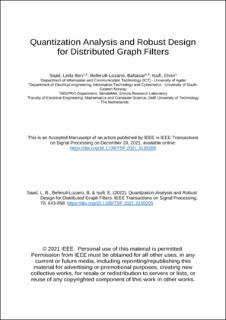| dc.contributor.author | Saad, Leila Ben | |
| dc.contributor.author | Beferull-Lozano, Baltasar | |
| dc.contributor.author | Isufi, Elvin | |
| dc.date.accessioned | 2023-02-24T11:40:42Z | |
| dc.date.available | 2023-02-24T11:40:42Z | |
| dc.date.created | 2022-01-04T12:14:40Z | |
| dc.date.issued | 2021 | |
| dc.identifier.citation | Saad, L. B., Beferull-Lozano, B. & Isufi, E. (2022). Quantization Analysis and Robust Design for Distributed Graph Filters. IEEE Transactions on Signal Processing, 70, 643-658. | en_US |
| dc.identifier.issn | 1053-587X | |
| dc.identifier.uri | https://hdl.handle.net/11250/3053834 | |
| dc.description.abstract | Distributed graph filters have recently found appli- cations in wireless sensor networks (WSNs) to solve distributed tasks such as reaching consensus, signal denoising, and recon- struction. However, when implemented over WSNs, the graph filters should deal with network limited energy constraints as well as processing and communication capabilities. Quantization plays a fundamental role to improve the latter but its effects on distributed graph filtering are little understood. WSNs are also prone to random link losses due to noise and interference. In this instance, the filter output is affected by both the quantization error and the topological randomness error, which, if it is not properly accounted in the filter design phase, may lead to an accumulated error through the filtering iterations and significantly degrade the performance. In this paper, we analyze how quantization affects distributed graph filtering over both time-invariant and time-varying graphs. We bring insights on the quantization effects for the two most common graph filters: the finite impulse response (FIR) and autoregressive moving average (ARMA) graph filter. Besides providing a comprehensive anal- ysis, we devise theoretical performance guarantees on the filter performance when the quantization stepsize is fixed or changes dynamically over the filtering iterations. For FIR filters, we show that a dynamic quantization stepsize leads to more control on the quantization noise than the fixed-stepsize quantization. For ARMA graph filters, we show that decreasing the quantization stepsize over the iterations reduces the quantization noise to zero at the steady-state. In addition, we propose robust filter design strategies that minimize the quantization noise for both time- invariant and time-varying networks. Numerical experiments on synthetic and two real data sets corroborate our findings and show the different trade-offs between quantization bits, filter order, and robustness to topological randomness. | en_US |
| dc.language.iso | eng | en_US |
| dc.title | Quantization Analysis and Robust Design for Distributed Graph Filters | en_US |
| dc.type | Journal article | en_US |
| dc.type | Peer reviewed | en_US |
| dc.description.version | acceptedVersion | en_US |
| dc.rights.holder | © 2021 IEEE. | en_US |
| dc.source.pagenumber | 643-658 | en_US |
| dc.source.volume | 70 | en_US |
| dc.source.journal | IEEE Transactions on Signal Processing | en_US |
| dc.identifier.doi | https://doi.org/10.1109/TSP.2021.3139208 | |
| dc.identifier.cristin | 1974278 | |
| dc.relation.project | Universitetet i Agder: Wisenet | en_US |
| dc.relation.project | Norges forskningsråd: 270730 | en_US |
| dc.relation.project | Norges forskningsråd: 250910 | en_US |
| cristin.ispublished | true | |
| cristin.fulltext | postprint | |
| cristin.qualitycode | 2 | |
